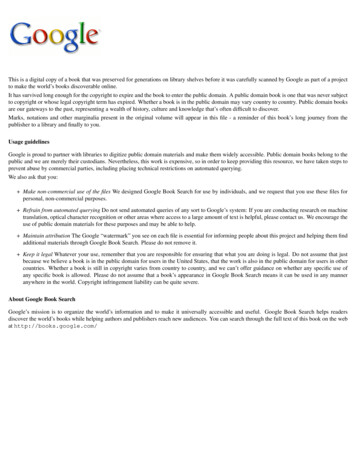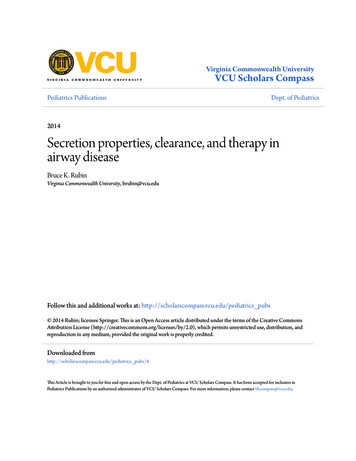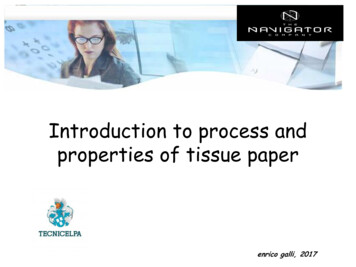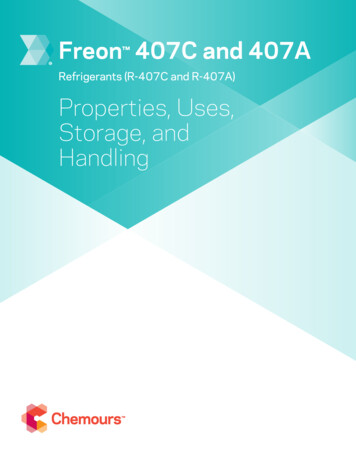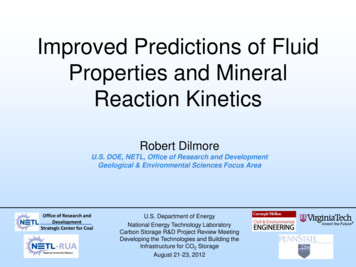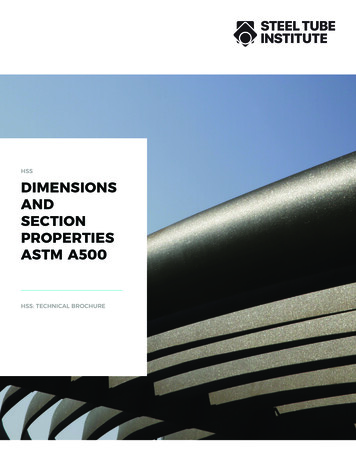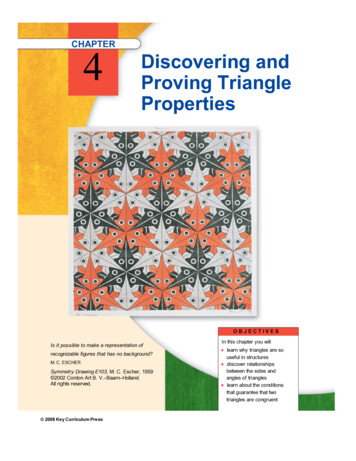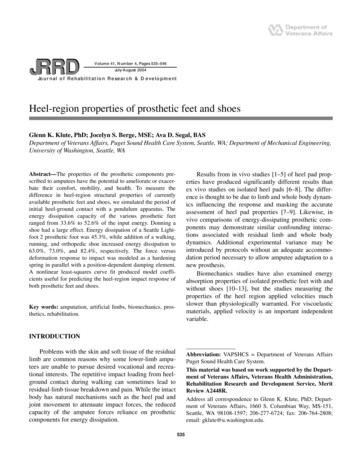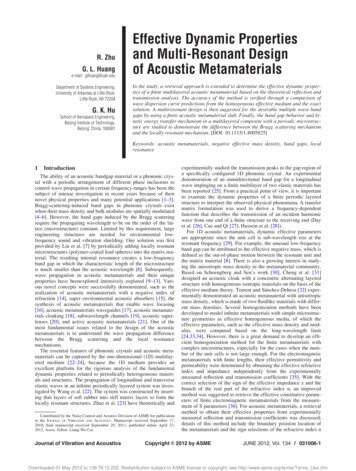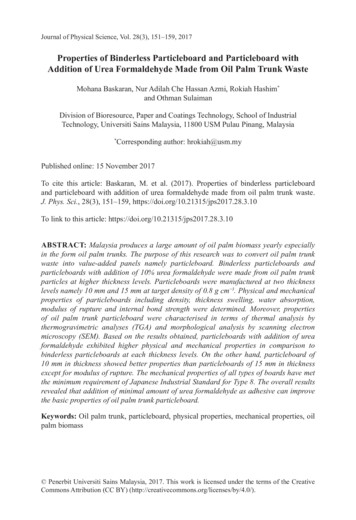
Transcription
Journal of Physical Science, Vol. 28(3), 151–159, 2017Properties of Binderless Particleboard and Particleboard withAddition of Urea Formaldehyde Made from Oil Palm Trunk WasteMohana Baskaran, Nur Adilah Che Hassan Azmi, Rokiah Hashim*and Othman SulaimanDivision of Bioresource, Paper and Coatings Technology, School of IndustrialTechnology, Universiti Sains Malaysia, 11800 USM Pulau Pinang, MalaysiaCorresponding author: hrokiah@usm.my*Published online: 15 November 2017To cite this article: Baskaran, M. et al. (2017). Properties of binderless particleboardand particleboard with addition of urea formaldehyde made from oil palm trunk waste.J. Phys. Sci., 28(3), 151–159, https://doi.org/10.21315/jps2017.28.3.10To link to this article: https://doi.org/10.21315/jps2017.28.3.10ABSTRACT: Malaysia produces a large amount of oil palm biomass yearly especiallyin the form oil palm trunks. The purpose of this research was to convert oil palm trunkwaste into value-added panels namely particleboard. Binderless particleboards andparticleboards with addition of 10% urea formaldehyde were made from oil palm trunkparticles at higher thickness levels. Particleboards were manufactured at two thicknesslevels namely 10 mm and 15 mm at target density of 0.8 g cm 3. Physical and mechanicalproperties of particleboards including density, thickness swelling, water absorption,modulus of rupture and internal bond strength were determined. Moreover, propertiesof oil palm trunk particleboard were characterised in terms of thermal analysis bythermogravimetric analyses (TGA) and morphological analysis by scanning electronmicroscopy (SEM). Based on the results obtained, particleboards with addition of ureaformaldehyde exhibited higher physical and mechanical properties in comparison tobinderless particleboards at each thickness levels. On the other hand, particleboard of10 mm in thickness showed better properties than particleboards of 15 mm in thicknessexcept for modulus of rupture. The mechanical properties of all types of boards have metthe minimum requirement of Japanese Industrial Standard for Type 8. The overall resultsrevealed that addition of minimal amount of urea formaldehyde as adhesive can improvethe basic properties of oil palm trunk particleboard.Keywords: Oil palm trunk, particleboard, physical properties, mechanical properties, oilpalm biomass Penerbit Universiti Sains Malaysia, 2017. This work is licensed under the terms of the CreativeCommons Attribution (CC BY) (http://creativecommons.org/licenses/by/4.0/).
Properties of Binderless Particleboard and Particleboard1.152INTRODUCTIONMalaysia is one of the largest producers of palm oil in the world with huge areasof oil palm plantation. The palm oil has a high demand in many countries as itcan be used for various applications including in food such as cooking oil andmargarines, and also in non-food industries such as detergents, shampoo andbiofuel.1 Consequently, a large amount of waste has been generated from oil palmplantation due to high-value utilisation of palm oil. Other parts of oil palm treenamely trunk, fronds and empty fruit bunch are considered a solid waste once theyreach economic life span of 25 years.2Wastes obtained from oil palm plantation give rise to environmental issues due toimproper disposal of the residues such as open burning which leads to major airpollution. Since a massive amount of solid waste is generated yearly, they can beutilised efficiently and effectively for production of value-added products such asfibre-based products, wood-based composite products and building construction,as well as sources of energy.3With a limited supply of wood material arising from depleting forest resources,wood-based industry is searching for wood substitute. Utilisation of waste fromoil palm plantations will solve the demand for wood materials and thus reducedisposal of those wastes. Many studies have been conducted to explore new usageof oil palm waste especially for wood-based panels, where it has been utilised asraw materials for particleboard, plywood and fibreboard production.4The intention of particleboard without addition of any adhesive is an alternativeway to reduce and eliminate the use of synthetic resin and to produce anenvironmentally friendly product. Furthermore, much effort has been put onutilisation of agricultural waste or lignocellulosic materials from oil palm trunk,kenaf fibre, empty fruit bunch and also coconut husk.5 Hashim et al. have exploredutilisation of oil palm trunk for the production of binderless particleboard whereit can emit usage of synthetic adhesive which is hazardous to human health.6However, the basic properties of oil palm trunk binderless particleboard still needimprovisation.In this study, urea formaldehyde was added as adhesive at a low percentage toimprove the basic properties of oil palm trunk particleboard in comparisonto binderless boards. Furthermore, particleboard of higher level of thicknesswas manufactured to diversify its end product purpose. Baskaran et al. havesuccessfully manufactured boards at higher thickness levels.7 However, in thisstudy, the influence of urea formaldehyde on higher thickness levels oil palm trunkparticleboard was investigated.
Journal of Physical Science, Vol. 28(3), 151–159, 20172.153EXPERIMENTALRaw materials used for particleboard production in this study are oil palm trunkparticles which were supplied by Encore Agricultural Industries Sdn Bhd. Oilpalm trunk particleboards were manufactured at two thickness levels of 10 mmand 15 mm with two different conditions namely binderless particleboard andparticleboard with addition of urea formaldehyde at a target density 0.80 g cm 3.Oil palm particles were weighted and placed into a mould with dimension20.5 cm 20.5 cm followed by pre-pressing for 3 min to form a mat at targetthicknesses of 10 mm and 15 mm. Unlike binderless particleboard, particleboardwith addition of urea formaldehyde were manufactured with addition of 10% ofurea formaldehyde adhesive, which were calculated based on air dried weight ofoil palm trunks, was mixed manually with oil palm particles before formed intomat. The mat was pressed at manufacturing condition at a pressure of 5 MPa andtemperature of 180 C for 20 min.7 A total of 24 single-layer particleboards where6 replicates were manufactured for each type of particleboards.2.1Testing of ParticleboardsPhysical and mechanical properties of boards that were carried out include density,thickness swelling and water absorption, modulus of rupture and internal bondstrength according to Japanese Industrial Standard JIS A 5908: 2003 Particleboard.8Three specimens from each board with the dimension of 5 cm 5 cm were usedto determine thickness swelling and water absorption by soaking them in water for24 h. The thickness of each specimen was measured before and after water soakingat four points of midway along each side and 1 cm from the edge at accuracy of0.01 mm. One specimen for modulus of rupture and three specimens for internalbond strength with the dimension of 5 cm 15 cm, and 5 cm 5 cm respectivelywere prepared from each type of board for the evaluation of mechanical properties.Both tests were done on an Instron Testing System Model UTM-5582 equippedwith a load cell capacity of 1000 kg.2.2Thermal AnalysisThe thermogravimetric analysis (TGA) analysed thermal stability of materialsat different temperatures were conducted using a Perkin Elmer TGA 7thermogravimetric analyser. Scans were recorded from 30 C to 800 C for samplesof 5–10 mg placed in an aluminium pan with a heating rate of 20 C min 1 under anitrogen atmosphere.
Properties of Binderless Particleboard and Particleboard2.3154Morphological AnalysisScanning electron microscopy (SEM) was employed to analyse morphologicalstructure of oil palm trunk particles between binderless particleboard andparticleboard with addition of urea formaldehyde. Micrographs were taken fromcross sections of 0.5 cm 0.5 cm of experimental panels. The samples were coatedwith gold by an ion sputter coater (Polaron SC515, Fisons Instruments, UK).A Scanning Electron Microscope LEO Supra 50 Vp, Field Emission SEM, CarlZeiss SMT, Oberkochen, Germany was employed for microscopic study.3.RESULTS AND DISCUSSION3.1Evaluation on Water Absorption and Thickness SwellingThe physical properties, namely thickness swelling and water absorption ofbinderless particleboard and particleboard with addition of urea formaldehydeare shown in Table 1 which was evaluated by Tukey Test. Based on the resultobtained in Table 1, binderless particleboard with thickness of 15 mm had thehighest water uptake compared to other boards. The water absorption values ofbinderless particleboard improved as the addition of urea formaldehyde in the oilpalm trunk particleboard. The values significantly reduced by 4.86% and 12.95%for particleboard with addition of urea formaldehyde at thickness levels of 10 mmand 15 mm respectively. Thickness swelling of the boards with 10 mm in thicknessreduced significantly to 21.93% while 55.28% for boards in 15 mm in thicknesswhen the addition of urea formaldehyde compared to binderless particleboard.Table 1: Physical and mechanical properties of binderless particleboard (B) andparticleboard with addition of urea formaldehyde (U).Types ofboardsDensity(g cm 3)Thicknessswelling (%)Waterabsorption (%)Modulus ofrupture (MPa)Internal bondstrength (MPa)10 B0.80 (0.015)40.08 (4.68)b83.45 (11.42)b8.08 (1.15)a0.84 (0.41)a,b10 U0.80 (0.009)32.87 (5.71)a79.58 (11.31)a10.28 (1.18)b1.44 (0.64)c15 B0.80 (0.011)51.63 (6.18)98.31 (12.19)13.05 (1.35)0.64 (0.54)a15 U0.80 (0.010)33.25 (5.44)acc87.04 (12.25)bc15.20 (1.20)d1.20 (0.61)b,cNotes: 10 and 15 represent thickness levels; values in parenthesis are standard deviation; different letters insuperscript represent statistical significance while same letters indicate a similarity of differences (p 0.05).The rate of water absorption in particleboard also depends on the board thickness.The higher thickness boards have higher percentage of water uptake. Besidesthat, there is a significant increase of 28.82% for water absorption and 17.81% forthickness swelling as increasing thickness of oil palm binderless particleboard.
Journal of Physical Science, Vol. 28(3), 151–159, 2017155Oil palm trunk is a highly hygroscopic material which can absorb higher moisturefrom the surroundings.9 Hence, the absorption of water by particleboard wasaffected by the hygroscopic properties of oil palm trunk. However, the percentageof water uptake was lower for particleboards with addition of urea formaldehyde.The porosity of the boards was reduced by addition of urea formaldehyde resin.The particles that have been pressed and show high compaction level are attributedto low water penetration and diffusion into the boards, as the particleboards havelow capacity to absorb water.103.2Evaluation on Modulus of RuptureModulus of rupture of all particleboards met the requirement of the JapaneseIndustrial Standard for Type 8.8 The values improved with the presence of ureaformaldehyde and also higher thickness. As can be seen in Table 1, modulus ofrupture values increase significantly by 27.23% for board of 10 mm in thicknessand 16.48% for board of 15 mm in thickness as addition of urea formaldehydein comparison to binderless particleboard. Whereas, a significantly increaseof 61.48% and 47.86% were found as increasing thickness level for binderlessparticleboard and board with addition of urea formaldehyde.The binderless particleboard had lowest bending strength because the strength ofboard was attributed by self-bonding process only. Moreover, types of raw materialalso affect the strength values since oil palm trunk has lower strength values.6Thus, addition of adhesive like urea formaldehyde can form a strong fibre contactwithin oil palm particles. It is revealed from the result obtained where boards withaddition of urea formaldehyde have high modulus of rupture values.3.3Evaluation on Internal Bond StrengthThe internal bond strength for particleboard with addition of urea formaldehyde washigher than binderless particleboard. The values increased significantly as additionof urea formaldehyde with 71.43% and 87.50% for particleboard with thicknesslevel of 10 mm and 15 mm respectively as shown in Table 1. Urea formaldehydeenhanced the bonding between particles and fibres especially during hot pressingprocess. Internal bond values reduced as increasing thickness level of board.Particleboard of 10 mm in thickness with addition of 10% urea formaldehyde hashighest internal bond strength. High compaction ratio between oil palm particles atlower thickness and also addition formaldehyde based adhesive improved bondingbetween raw materials resulted in high mechanical properties. The higher internalbond was contributed by high cellulose content and moderate lignin content of oilpalm trunk samples.11 All types of particleboard made from oil palm trunk haveexceeded the minimum requirement of Japanese Industrial Standard for Type 8.8
Properties of Binderless Particleboard and Particleboard3.4156Evaluation on Thermal DegradationThe thermal degradation for binderless particleboards and particleboards withaddition of urea formaldehyde are shown in Figure 1. Figure 1(a) represents theweight loss curve (TG) and Figure 1(b) represents derivative thermogravimetric(DTG) profiles. The curves show that the weight starts to decreased when thetemperature is increased between 200 C and 300 C. This is because the materialsbegin to absorb the heat energy.12(a)(b)Figure 1: (a) TG and (b) DTG curve of binderless particleboard (B) and particleboardwith addition of urea formaldehyde (U) at different thickness levels of 10 mmand 15 mm.
Journal of Physical Science, Vol. 28(3), 151–159, 2017157The weight loss in binderless particleboard is lower compared to board withaddition of urea formaldehyde. This indicates that urea formaldehyde has goodstructural stability. It can be concluded that binderless particleboard thermallydegraded faster compared to particleboard with addition of urea formaldehyde.Particleboard with addition of urea formaldehyde takes slightly longer time todegrade as the oil palm particles are bonded together with urea formaldehyde.Hence, the presence of adhesive produces stronger crosslinking of hydrogen bondand hard to be broken. As a result, the degradation of materials required moreheat energy. The peak temperature shows where the maximum weight loss occurs.First and foremost, hemicellulose will degrade followed by cellulose. Compared tohemicellulose and cellulose, degradation of lignin required a longer period of timeto ensure the decomposition is complete.133.5Evaluation on Morphological PropertiesThe morphological properties of binderless particleboard and particleboard withaddition of urea formaldehyde can be observed from SEM analysis as illustratedin Figure 2.Figure 2: Micrographs of binderless particleboard (left) and particleboard with additionof urea formaldehyde (right).From Figure 2, compressed cell walls and fibres of oil palm trunk can be seenclearly from the micrograph. This is due to high pressure applied during hotpressing when particleboard was manufactured. Hot pressing helps adhesive tomelt and disperse evenly within the oil palm particles. Besides, adhesive causedthe particles to become bonded together and more bonding are formed. Hence,
Properties of Binderless Particleboard and Particleboard158particleboard with addition of urea formaldehyde has greater compactnesscompared to binderless particleboard. The presence of urea formaldehyde can beclearly seen as glue line in particleboard with addition of urea formaldehyde athigh magnification level in Figure 2(b). The presences of silica in the samples withaddition of urea formaldehyde were found in both thickness levels namely 10 mmand 15 mm. Besides that, the starch in oil palm trunk also can be detected from theFigure 2.4.CONCLUSIONProperties of binderless particleboard and particleboard with addition of ureaformaldehyde at two different levels of thickness, namely 10 mm and 15 mm wereinvestigated. Based on the result, urea formaldehyde was found to be a potentialadhesive as it improved physical and mechanical properties of oil palm trunkparticleboard at each level of thickness. Besides, the mechanical properties of alltypes of board have met the minimum requirement of Japanese Industrial Standardfor Type 8 which should have internal bond strength of 0.15 MPa in minimum andmodulus of rupture of 8.0 MPa in minimum. Particleboard of 10 mm in thicknessshowed better properties than particleboards of 15 mm in thickness except formodulus of rupture. Therefore, higher thickness boards are more suitable for lowerstrength application. The addition of 10% of urea formaldehyde improved physical,mechanical, thermal and morphological properties of oil palm trunk particleboard.As conclusion, oil palm trunk biomass especially oil palm trunk particles have agreat potential to be used in wood-based composites product especially for interiorapplications such as frame, cupboard, table, chair and accessories. Moreover, itcan help to minimise waste and conserve the environment by producing binderlessparticleboard with higher thickness levels.5.ACKNOWLEDGEMENTSThe authors express their gratitude to the Ministry of Higher Education Malaysiafor MyBrain15 scholarship to Mohana Baskaran. The authors also acknowledgeUniversity RU grant 1001/PTEKIND/814256. Assistance in raw materials suppliedby Kuala Lumpur Kepong Bhd. northern branch is also acknowledged.
Journal of Physical Science, Vol. 28(3), 151–159, 20171596.REFERENCES1.Lai, O. M., Tan, C. P. & Akoh, C. C. (2015). Palm oil: Production, processing,characterization, and uses. London: Elsevier.Wong, C. K. & Bernardo, R. (2008). Genomewide selection in oil palm:Increasing selection gain per unit time and cost with small populations.Theoret. Appl. Gen., 116(6), 815–824, , E. (2008). Improvement of oil palm wood properties usingbioresin. Phd diss., Dresden University of Technology, Germany.Abdul Khalil, H. P. S. & Hashim, R. (2004). Komposit panel berasaskansumber kayu. Pulau Pinang: Penerbit Universiti Sains Malaysia.Hashim, R., Nadhari, W. N. A. W. & Sulaiman, O. (2016). Green binderlessboard from oil palm biomass. Renew. Energy Sustain. Technol. Build.Environ. Appl., 175–186, https://doi.org/10.1007/978-3-319-31840-0 11.Hashim, R. et al. (2011). Characterization of raw materials andmanufactured binderless particleboard from oil palm biomass. Mater. Des.,32(1), 246–254, ran, M. et al. (2015). Optimization of press temperature and timefor binderless particleboard manufactured from oil palm trunk biomassat different thickness levels. Mater. Today Comm., 3, 87–95, ese Industrial Standards Committee, JIS. (2003). JIS A 5908-2003particleboards. Tokyo: JIS.Wahida, A. F. & Ghazi, F. N. (2015). One layer experimental particleboardfrom oil palm frond particles and empty fruit bunches fibers. Int. J. Eng. Res.Technol., 4(1), 199–202.Leiva, P. et al. (2007). Medium density particleboards from rice husksand soybean protein concentrate. J. Appl. Polym. Sci., 106(2), im, R. et al. (2012). Properties of binderless particleboard panelsmanufactured from oil palm biomass. BioResour., 7(1), 1352–1365.Moubarik, A. et al. (2013). Polenta cornstarch-mimosa tannin-based ureaformaldehyde adhesives for interior grade particleboard. J. Mater. Environ.Sci., 4(4), 496–501.Wong, K. K. (2012). Optimising resin consumption, pressing time anddensity of particleboard made of mixes of hardwood sawmill residue andcustom flaked softwood. PhD diss., RMIT University, Melbourne.2.3.4.5.6.7.8.9.10.11.12.13.
mat. The mat was pressed at manufacturing condition at a pressure of 5 MPa and temperature of 180 C for 20 min.7 A total of 24 single-layer particleboards where 6 replicates were manufactured for each type of particleboards. 2.1 Testing of Particleboards Physical and mechanical pr

